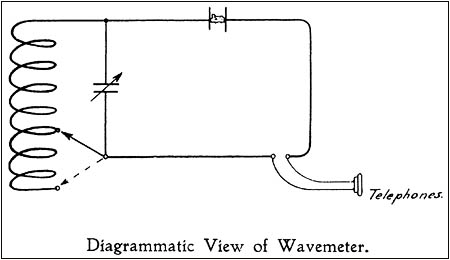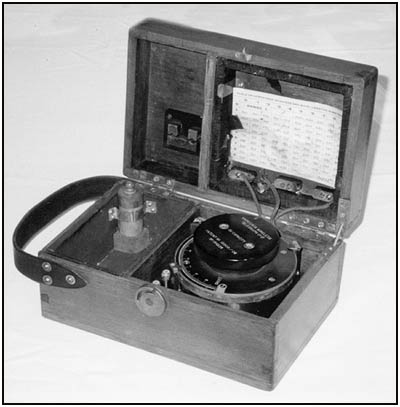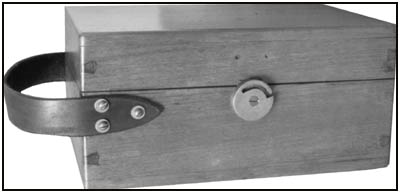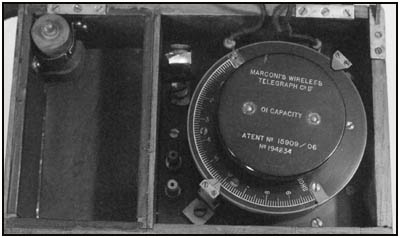Of Old Radios And Related Items--Published Monthly
The Marconi Wavemeter Number One
BY HOWARD STONE
Web Edition
In this article, Howard Stone provides a look at another piece of early wireless history in the form of a Marconi Wavemeter. His persistence in the search for information about his wavemeter is a model for any collector in pursuit of authentic restoration. (Editor)
Wavemeters measure the length of waves; they determine the frequency of a transmission or help calibrate the dial of a receiver. They were one of the first pieces of test equipment developed at the beginning of radio.

Figure 1. The schematic diagram for the Marconi Wavemeter Number One.
In 1906, Guglielmo Marconi first introduced the Marconi Wavemeter Number One in England. The first commercial wavemeter that Marconi made, it was used mainly at ship-to-ship and ship-to-shore installations. It typically covered the frequencies of 100-800 meters, though when introduced, this particular wavemeter was calibrated to measure from 200 to 1040 meters. Figure 1 shows the schematic of the Wavemeter Number One from an early Marconi catalogue. The circuit is very simple, like that of a basic crystal set.
I found the Marconi Wavemeter shown in Figures 2 and 3 while living in Cambridge, England, during the 2000 school year. It was a basket case. The glue was no longer holding, and it was falling apart at all of the joints. The leather was dried and curled up. It had to be soaked to soften it and refastened to the box on the left that holds the earphone.

Figure 2. A Marconi Wireless Telegraph Co. Wavemeter in its case after restoration by the author.
Because the wavemeter was in such poor shape, I was not sure how the finish should look. It did not look like other early Marconi apparatus I had seen. I tried to find one in someone's collection in the United Kingdom, but had no luck. The Science Museum in London had several later Marconi wavemeters, but not the Number One.
I contacted the Marconi archives in England; they replied that they had an example of this wavemeter in their collection but would not let me see it because the archives are not open to the public. Bad news for those studying or restoring early wireless. Finally, I mailed some stain chips and a list of specific questions to the archives and got some answers.

Figure 3. This view of the Wavemeter, with its cover closed, shows its dovetail construction and excellent restoration.
I found out what I suspected -- the wood of the case is teak, not mahogany, oak, or walnut, as one might expect in radios or wireless equipment. Still, teak makes sense for equipment used on shipboard. Fortunately, about half of the original finish was still there, so the rest of the finish could be blended in. The wavemeter's cabinet measures 95/16 x 61/2 x 41/2 inches.
The detector used in the wavemeter is a chunk of crystal wedged in between two 2" long pieces of spring brass to the back left of the condenser. The small, turned-round, wood box in the back of the earphone box is for spare crystals. The card in the lid is for calculating the wavelength. When fitted with an optional buzzer, the wavemeter can be used as a signal source to tune and calibrate receiving sets.
The Marconi Wavemeter Number One is a fine example of an early piece of test equipment.

Figure 4. A closeup of the Wavemeter shows the compartment for storage of a headset on the left, along with a storage box for extra crystals.
(Howard Stone, 2625 6th Ave., Fort Worth, TX 76110)
Howard Stone is a professor of Pastoral Counseling at Texas Christian University, Fort Worth, Texas. A longtime collector, he is especially interested in crystal sets and in wireless 1- and 2-tube battery sets of the early 1920s. His series of articles on British crystal sets has appeared in A.R.C.
Marconi Wavemeters
Nos. 1 and 2From: Marconi's Wireless Telegraph Co., Ltd. Marconi Receiving and Measuring Instruments, a Marconi catalog from the period
"This Wavemeter is the most practical instrument of its kind that has been introduced. It is extremely portable and self-contained.
"Wave lengths can be measured very rapidly, one minute being usually sufficient time to measure within .75 percent, providing the transmitting is not too damped.
"In the latest type of instrument, all the old defects in the condenser, such as brush contacts, have been eliminated. The instrument is far more sensitive than any Wavemeter using galvanometers or vacuum tubes, and consequently, waves not otherwise detectable can be measured with great ease. Used as a miniature transmitter with a shunted high-note buzzer and a dry cell, many receiving tests can be carried out without having resource to a distant station."
| [Free Sample] [Books, etc., For Sale] [Subscribe to A.R.C./Renew] [Classified Ads] [Auction Prices] [Event Calendar] [Links] [Home] [Issue Archives] [Book Reviews] [Subscription Information] [A.R.C. FAQ] URL = http://www.antiqueradio.com/Feb02_Stone_Wavemeter.html Copyright © 1996-2002 by John V. Terrey - For personal use only. Last revised: January 28, 2002. For Customer Assistance please contact ARC@antiqueradio.com or call (866) 371-0512 Pages designed/maintained by Wayward Fluffy Publications
Antique Radio Classified |